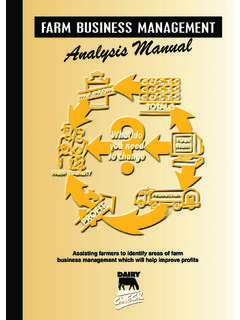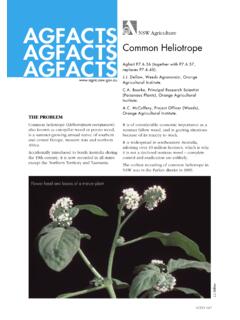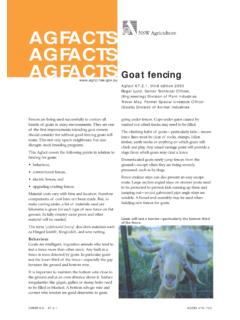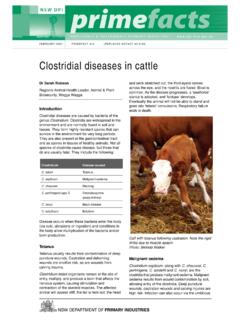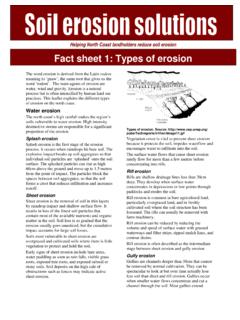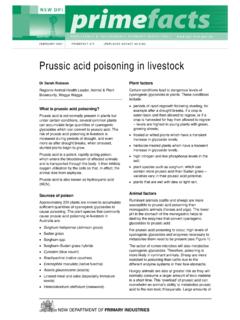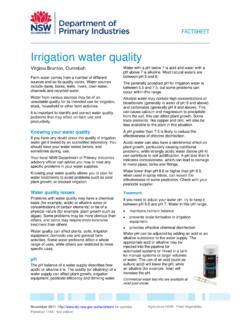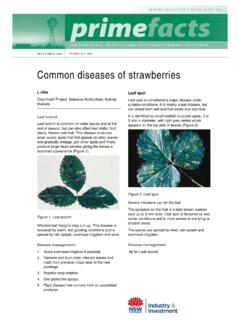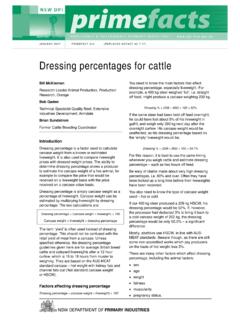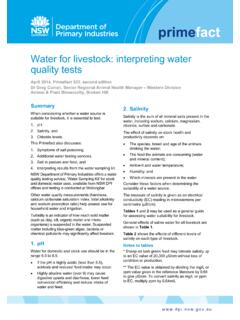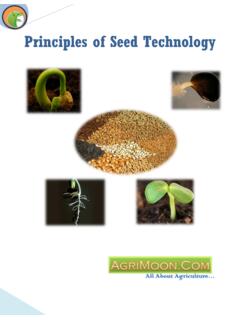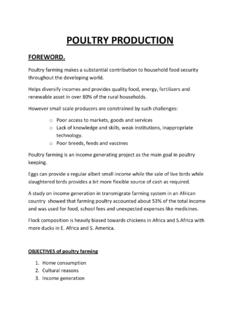Transcription of Procrop Maize growth & development
1 &DevelopmentThis book describes the growth and development of the Maize plant from germination to grain environmental factors and management actions that influence each growth stage are also growth & development State of New South Wales through NSW Department of Primary Industries 2009 DisclaimerThe information contained in this publication is based on knowledge and understanding at the time of writing (January 2009). However, because of advances in knowledge, users are reminded of the need to ensure that information upon which they rely is up to date and to check currency of the information with the appropriate officer of NSW Department of Primary Industries or the user s independent that some of the information in this document is provided by third parties, the State of New South Wales, the author and the publisher take no responsibility for the accuracy, currency.
2 Reliability and correctness of any information included in the document provided by third product trade names in this publication are supplied on the understanding that no preference between equivalent products is intended and that the inclusion of a product name does not imply endorsement by NSW Department of Primary Industries over any equivalent product from another READ THE LABELU sers of agricultural or veterinary chemical products must always read the label and any permit, before using the product, and strictly comply with the directions on the label and the conditions of any permit.
3 Users are not absolved from compliance with the directions on the label or the conditions of the permit by reason of any statement made or not made in this by NSW Department of Primary Industries, March 2009 ISBN 978 0 7347 1955 38603 AcknowledgmentsThis book is part of the Procrop series, a project funded by the Natural Heritage Edwards, District Agronomist (Cowra)AuthorThis book was compiled by NSW Department of Primary Industries District Agronomist Kieran O Keeffe (Coleambally).Other contributions and assistanceWe acknowledge Andrew Schipp, District Agronomist, Hay, for his contribution to the would like to thank our expert reviewers.
4 Steve Wilson, Corn Research Manager, Pioneer Hi-Bred Australia Rob McCarron, Corn and Sunflower Business Manager, Pacific Seeds Paul Newell, Corn Breeder, Pacific Seeds Don McCaffery, Technical Specialist, NSW DPIWe would also like to thank the Iowa State University for permission to reprint material from their Special Report 48 How a corn plant assistanceAnn Munroe, Scientific and General Editor, SydneyIllustrationsBarry Jensen, NSW DPI OrangeTemplate designBelinda Gersbach, NSW DPI OrangeLayoutBarry Jensen, NSW DPI OrangePhotographyKieran O Keeffe Dr Antonio Perdomo, Pioneer Hi-Bred Paul Newell, Pacific Seeds Steve Smith, Pioneer Hi-Bred Lowan Turton, NSW DPIpII | Procrop Maize growth & DEVELOPMENTC ontentsAcknowledgments IIPreface VIntroduction 1 Growing Maize 1 Maize types 2 Selecting varieties 5 Life cycle 5 The Maize kernel 6 The Maize plant 7 References and further reading 8 Chapter 1.
5 Germination and emergence 9 Germination VE 10 Emergence VE 10 Factors affecting germination and emergence 11 References and further reading 14In the paddock 15 Calculating sowing rate 15 Calculating seed spacing along the row 15 Calculating establishment density 16 Calculating growing degree-days (thermal time) 16 Chapter 2. Vegetative growth 19 Vegetative growth 20 Factors affecting vegetative growth 25 References and further reading 30In the paddock 31 Examining the root system 31 Assessing plant growth stage 31 Estimating herbage mass (kg DM/ha) 32 Monitoring for pests, diseases, nutrient deficiencies and injury 32 Chapter 3.
6 Reproductive development 33 Reproductive development 34 Factors affecting reproductive development 36 References and further reading 38In the paddock 39 Assessment of the tasselling/ silking or flowering stage 39 Pollination assessment: ear-shake/silk retention method 39| pIII 4. Kernel development 41 Kernel development 42 Maturity and drying 42 Factors affecting kernel development 43 References and further reading 46In the paddock 47 Determining milk-line score 47 Estimating yield 47 Calculating water-use efficiency 47 Glossary 48pIV | Procrop Maize growth & DEVELOPMENTP refaceThis book describes the growth and development of the Maize plant from germination to kernel filling.
7 It also provides the environmental factors that influence each growth stage and the management actions to optimise aim of Maize growth and development is to link plant physiology and crop management decisions. It will help agronomists and farmers to understand the life cycle of the Maize plant and the factors that influence growth and development , and to identify the different growth stages of the plant. This knowledge can then be applied to crop management to maximise yield and are four chapters in the book covering the progression of key stages in the life cycle of the Maize plant, and its growth and management.
8 Included in each chapter are practical exercises to show how knowledge of plant physiology can be applied in the paddock.| pV pVI | Procrop Maize growth & DEVELOPMENTG rowing maizeMaize is the third most important cereal crop species in the world (after wheat and rice) and is grown across a wide range of climates, but mainly in the warmer temperate regions and humid subtropics. Maize has multiple uses, including for human foods, animal feeds, and the manufacture of pharmaceutical and industrial products. It is the staple food source for people in many countries. As an animal feed it is highly desirable because of the high energy and feed value of the kernel, leaf and stem.
9 It is becoming increasingly important in many countries for industrial and pharmaceutical applications. It can be used to produce starch, ethanol and plastics and as a base for antibiotic production. Over the past 40 years the total global area sown to Maize has increased by about 40%, and production has is a C4 (tropical) plant. Compared with C3 (temperate) crops, Maize uses carbon dioxide, solar radiation, water and nitrogen more efficiently during photosynthesis. The water-use efficiency of Maize is approximately double that of C3 crops grown at the same sites. The transpiration ratio of Maize (molecules of water lost per molecule of carbon dioxide fixed) is 388, whereas that of wheat is 613 and soybean South Wales productionTemperature and available moisture determine where Maize is grown in NSW (Figure i).
10 Production areas include the North Coast, Liverpool Plains, Northwest Slopes and Plains and that of Southern Introductionby Kieran O Keeffe and Andrew SchippC3 plantHas a normal type of photosynthesis: carbon dioxide is first incorporated into a 3-carbon compound. Most plants are C3 plants. Examples of C3 plants are wheat, barley and plantHas a specialised type of photosynthesis: carbon dioxide is first incorporated into a 4-carbon compound. C4 plants carry out photosynthesis faster than C3 plants under high light intensity and high temperatures. This gives better water use efficiency compared with that of C3 plants at the same location, because the stomata (pores) are open for a shorter period of districts.
